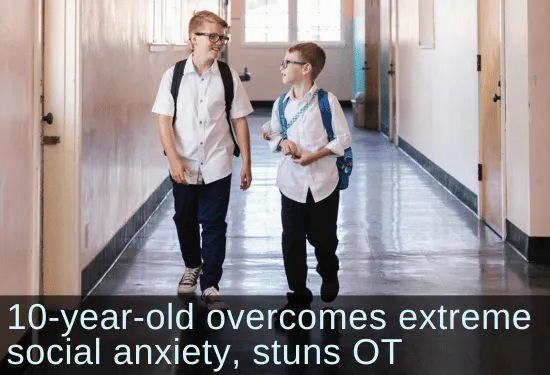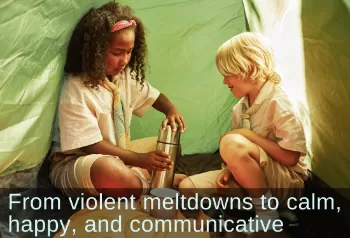Transforming Selective Mutism with Primitive Reflex Integration
by Sonia Story, M.S.
Selective mutism is considered an anxiety disorder (Driessen et al., 2020), and in particular, a social anxiety disorder (Muris & Ollendick, 2021).
Often parents of children with selective mutism can sense a child's intense anxiety during social situations. But it is challenging to know where the anxiety comes from. Researchers have characterized selective mutism as a stress reaction whereby the nervous system freezes, rendering the individual unable to speak in some situations, even though they speak easily in other situations (Melfsen et al., 2021).
Is the Fear Paralysis Reflex at the Root of Selective Mutism?
The Fear Paralysis Reflex is a primitive freeze response to perceived threats or fearful situations. It may be that an underlying Fear Paralysis Reflex is active when a child is unable to produce speech in certain situations. Thankfully, we can use targeted movements to release the grip of this primitive reflex to unlock speech for children with selective mutism.
Selective mutism is associated not only with anxiety, but also with "sensory-processing sensitivities" which were found to be significantly higher in children with selective mutism than in a group of control children with no selective mutism (Melfsen et al., 2021). When viewed from the lens of development, it appears that selective mutism is associated with delayed maturation of the nervous system and sensory systems. Both nervous and sensory systems are matured by the action of neurodevelopmental movements—the movements of infancy including primitive reflexes, postural reflexes, rhythmic movements, and developmental movements. See how neurodevelopmental movements help with both anxiety and sensory disorders.
 This OT used rhythmic movements and primitive reflex integration to calm anxiety and pave the way for this young boy to interact with teachers and classmates. Read about his journey from being unable to make eye contact or speak to chatting and playing with a friend.
This OT used rhythmic movements and primitive reflex integration to calm anxiety and pave the way for this young boy to interact with teachers and classmates. Read about his journey from being unable to make eye contact or speak to chatting and playing with a friend.
 Find out how this mother used rhythmic movements and primitive reflex integration activities from the Brain and Sensory Foundations course to help her 8-year-old daughter overcome selective mutism and severe behaviors.
Find out how this mother used rhythmic movements and primitive reflex integration activities from the Brain and Sensory Foundations course to help her 8-year-old daughter overcome selective mutism and severe behaviors.
 Before participating in a movement program, the 8-year-old student who drew these pictures struggled with selective mutism. With regular rhythmic movement, this student’s strides amazed her speech therapist: She now reads aloud in class and joined her school’s Drama Club.
Before participating in a movement program, the 8-year-old student who drew these pictures struggled with selective mutism. With regular rhythmic movement, this student’s strides amazed her speech therapist: She now reads aloud in class and joined her school’s Drama Club.
References
Driessen, J., Blom, J. D., Muris, P., Blashfield, R. K., & Molendijk, M. L. (2020). Anxiety in children with selective mutism: a meta-analysis. Child Psychiatry & Human Development, 51, 330-341.
Melfsen, S., Romanos, M., Jans, T., & Walitza, S. (2021). Betrayed by the nervous system: a comparison group study to investigate the ‘unsafe world’model of selective mutism. Journal of Neural Transmission, 128(9), 1433-1443.
Muris, P., & Ollendick, T. H. (2021). Selective mutism and its relations to social anxiety disorder and autism spectrum disorder. Clinical child and family psychology review, 24(2), 294-325.
Sonia Story, M.S. has been teaching neurodevelopmental movements since 2006.
Sonia developed the Brain and Sensory Foundations program to provide comprehensive training in neurodevelopmental movements—combining innate rhythmic movements, play, primitive reflexes, and postural reflexes.
She earned a Bachelor's degree in biology/psychology and a Master’s degree in Movement Sciences. She is the author of The Importance of Reflex Integration and the Evidence eBook, giving the rationale and evidence basis for using neurodevelopmental movements for helping with challenges such as ADHD, Sensory Processing Disorders, anxiety, emotional dysregulation, visual skill deficits, poor social skills, gross and fine motor delays and other neurodevelopmental and behavioral disorders.
Her work is featured in numerous podcasts, summits, and conferences, and in the books Almost Autism: Recovering Children from Sensory Processing Disorder; Special Ed Mom Survival Guide; Family Health Revolution; and Same Journey, Different Paths—Stories of Auditory Processing Disorder.
Sonia’s mission is to help children and families experience the profound benefits of neurodevelopmental and integrative movements for more functional and fulfilling lives.


